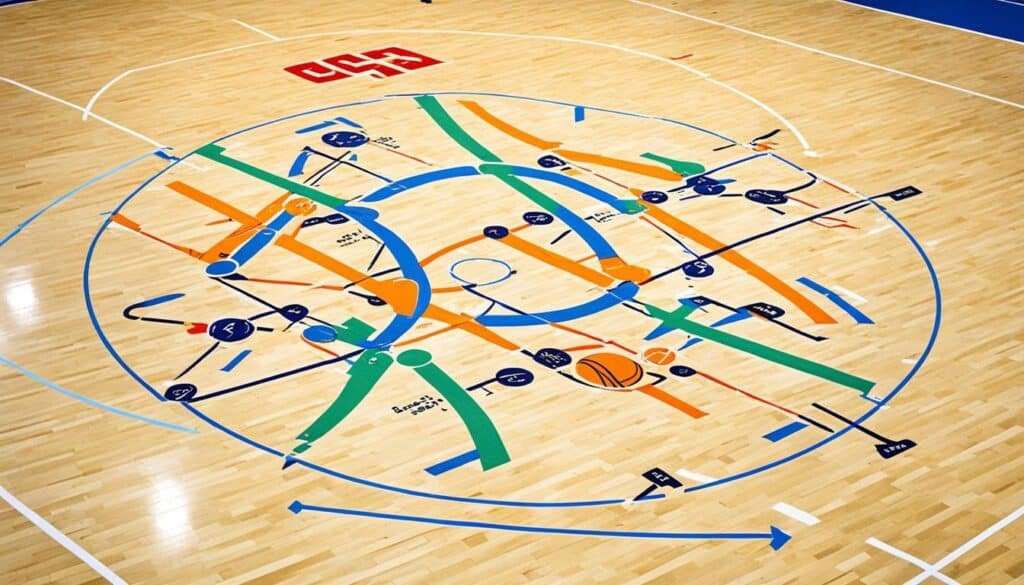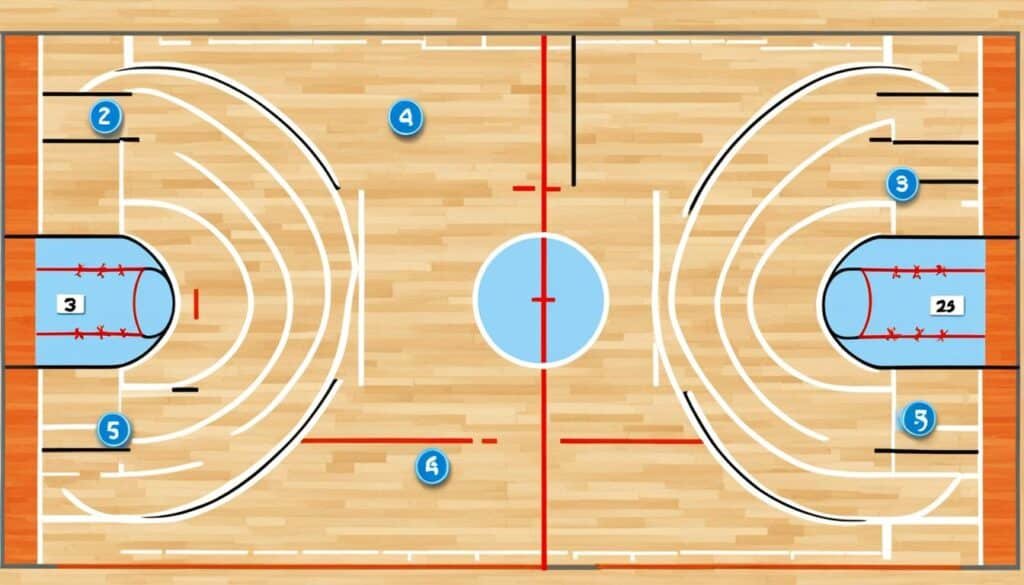Coaching your team’s basketball plays can sometimes be an overwhelming experience. Every coach and team needs a variety of basketball plays to get high-percentage shots and scoring opportunities for their players. In this article, we’ll explore different types of basketball plays, offensive and defensive strategies, and coaching tips to help you develop winning game tactics.
Key Takeaways: Basketball Plays And Strategies
- Understanding different types of basketball plays is essential for a well-rounded game strategy.
- Offensive strategies include half court sets, motion offenses, press breaks, and zone offenses.
- Defensive plays and tactics are crucial for disrupting opponents and creating scoring opportunities.
- Coaching tips will help you guide your team to success on the court.
- A solid foundation of fundamental skills is the key to mastering basketball plays and strategies.
Types of Basketball Plays
When it comes to basketball plays, there are various strategies and sets that teams can employ to maximize scoring opportunities and outwit the defense. Whether it’s half-court offensive sets, baseline and sideline out of bounds plays, motion offenses, press breaks, or zone offenses, understanding these different play types can help teams execute their game plan with precision and effectiveness.
Half-Court Offensive Sets
Half-court offensive sets are specifically designed to create scoring opportunities against a structured defense. These sets can involve a range of actions such as pick and roll plays, dribble handoffs, cross screens, and backdoor cuts. By utilizing these tactics, teams can exploit defensive weaknesses and create open looks for their players.
Motion Offenses
Motion offenses are characterized by continuous player movement and specific alignments. These offenses can be based on different patterns or formations, such as 5-out or 4-out. By constantly moving and making decisions based on reads and principles, teams can keep the defense on their toes and create scoring opportunities through spacing and ball movement.
Zone Offenses
Zone offenses are tailored to counter zone defenses, where players position themselves strategically to exploit gaps and create scoring opportunities. These offenses can involve both set plays and motion-based strategies to break down the defense and find high-percentage shots.
Baseline and Sideline Out of Bounds Plays
When the ball goes out of bounds, either on the baseline or sideline, teams have the opportunity to set up specific plays to get the ball in play and score. Baseline and sideline out of bounds plays aim to create advantages or open shots for offensive players while preventing turnovers. These plays can be executed from different formations, such as box formations or screen the screener plays.
Understanding and implementing these various play types can give teams a competitive edge on the court. Coaches and players can use them strategically to exploit defensive weaknesses, create scoring opportunities, and ultimately achieve success.
Types of Basketball Plays (continued)

In addition to the various types of basketball plays discussed in the previous section, there are several other strategic maneuvers and offensive patterns that teams can employ to gain a competitive edge. Incorporating these plays into your arsenal can enhance your team’s scoring opportunities and create confusion for the opposing defense.
Pick and Roll Plays
Pick and roll plays are commonly used in basketball to initiate a dynamic offensive sequence. In this play, one offensive player sets a screen for the ball handler, enabling them to either drive to the basket or pass to the screener. The pick and roll play exploits defensive gaps and creates mismatches, providing the offensive team with advantageous scoring opportunities.
Dribble Handoffs
Similar to pick and roll plays, dribble handoffs involve an offensive player handing off the ball to a teammate instead of setting a screen. This play requires precise timing and coordination between the two players involved. Dribble handoffs can disrupt the defense’s positioning and open up passing lanes, allowing for quick scoring opportunities.
Cross Screens and Backdoor Cuts
Cross screens and backdoor cuts are strategic movements designed to outmaneuver the defense and create scoring opportunities for post players. Cross screens involve an offensive player setting a screen on the weak side of the court, allowing a teammate to cut to the basket for a potential scoring opportunity. Backdoor cuts involve an offensive player quickly changing direction and cutting behind the defense to receive a pass near the basket, catching the defense off guard.
Motion Offenses
Motion offenses are continuous patterns of movement and decision-making that keep the defense guessing. Players in motion offenses move strategically based on reads and principles, aiming to create open shots and scoring opportunities. These offenses can be based on general continuous patterns or specific alignments, such as the 5-out or 4-out formations.
Implementing these types of basketball plays in your team’s strategy can lead to increased offensive efficiency and scoring success. By utilizing pick and roll plays, dribble handoffs, cross screens, backdoor cuts, and motion offenses, you can keep the defense on their toes and create favorable matchups for your players.
| Play Type | Description |
|---|---|
| Pick and Roll Plays | One offensive player sets a screen for the ball handler to create scoring opportunities. |
| Dribble Handoffs | An offensive player hands off the ball to a teammate instead of setting a screen. |
| Cross Screens | An offensive player sets a screen on the weak side to create a cutting opportunity. |
| Backdoor Cuts | An offensive player quickly changes direction and cuts behind the defense to receive a pass near the basket. |
| Motion Offenses | Continuous patterns of movement and decision-making to create open shots and scoring opportunities. |
| 5-out | An offensive alignment with all five players positioned on the perimeter. |
| 4-out | An offensive alignment with four players positioned on the perimeter and one in the post. |
Zone Offense Strategies

When facing a zone defense, having an effective zone offense strategy becomes crucial for scoring. One common zone defense is the 2-3 zone, but there are other variations that require different plays to break through. In zone offense, there are various techniques that can be employed to create high-percentage scoring opportunities for your team.
A popular tactic in zone offense is to utilize the high-post screen. By setting screens in the high post, offensive players can create openings for themselves or their teammates by forcing the zone defenders to make decisions. This strategic play creates confusion within the defense and allows for high-percentage scoring opportunities near the basket.
Another effective approach is to involve low-post plays. By utilizing post players near the baseline or the low-post area, teams can exploit the vulnerabilities of a zone defense. With the right positioning and execution, these plays can lead to easy baskets or open passing lanes for cutters.
“”Zone offense is all about finding those high-percentage scoring opportunities. Whether it’s through the high-post screen or low-post plays, the goal is to break down the defense and create easy baskets.”” – Coach Smith
In addition, running motion-based offenses can be effective against zone defenses. By continuously moving players and utilizing ball movement, offenses can create confusion and force the defense to rotate, creating openings for shooters or cutters.
It’s also important to consider ball screening the zone. By setting screens on the zone defenders, offenses can force switches or defensive breakdowns, leaving gaps for players to exploit. This technique can create scoring opportunities both inside and outside the paint.
Zone offense requires a combination of strategic plays and player movements to create scoring opportunities against the zone defense. By utilizing high-post screens, low-post plays, and motion-based offenses, teams can effectively break down the defense and find high-percentage scoring opportunities.
Baseline and Sideline Out of Bounds Plays

When it comes to basketball, every possession counts. Baseline and sideline out of bounds plays are strategic maneuvers designed to make the most out of these valuable opportunities. Whether you’re looking to score or simply maintain possession, these plays can make a significant impact on the outcome of the game.
One popular tactic utilized in out of bounds plays is the box formation. This formation involves positioning players in a square-like shape near the baseline or sideline, creating multiple passing options that can confuse the defense. By employing well-executed inbound passes and precise ball movement, teams can create scoring opportunities or find an open player for a high-percentage shot.
An alternative strategy is to utilize screen the screener plays. This involves setting screens to free up players for open shots or cuts to the basket. By creating screens within screens, teams can disrupt the defense’s positioning and create confusion, increasing the likelihood of finding an open player.
One key objective in these plays is to generate a shot on the block. This involves positioning a player near the low post area, where they can receive the ball and attempt a close-range shot. This play is particularly effective when executing against a defense that struggles to defend the low post effectively.
| Advantages of Baseline and Sideline Out of Bounds Plays |
|---|
| Creates scoring opportunities |
| Confuses the defense |
| Increases the likelihood of finding open players |
| Sets up high-percentage shots |
| Utilizes screens to disrupt the defense |
| Positions players for shots on the block |
Integrating these plays into your team’s offensive strategy can give you a competitive edge. However, it’s essential to consider the specific dynamics of your team and the strengths of individual players. By tailoring these plays to fit your team’s style and capitalizing on their skills, you can significantly impact the game’s outcome.
Example Play: Box Formation
- Player 1 starts inbounding the ball from the sideline.
- Player 2 positions themselves at the far corner of the free-throw line extended.
- Player 3 sets a screen on Player 2’s defender, allowing Player 2 to cut to the basket or receive a pass for an open shot.
- Player 4 fakes a cut towards the basket and then quickly cuts towards the sideline, receiving a pass from Player 1.
- Player 5 moves towards the top of the key, providing an additional passing option.
- Player 4 can choose to shoot, pass to Player 2, pass to Player 5, or look for another open player.
By incorporating these baseline and sideline out of bounds plays into your team’s offensive arsenal, you can elevate your game and create scoring opportunities that can make all the difference on the scoreboard.
Situational Basketball Plays

In addition to basic plays, coaches should have situational plays ready for specific time and score situations. These plays are designed to give your team the best chance for success in critical moments of the game.
Time and Score Management
Understanding the time and score is crucial when executing situational basketball plays. Whether you’re down by 3 with 10 seconds to go or winning by 7 with a minute remaining, the right play can make all the difference.
“Time is of the essence in basketball. Knowing how to capitalize on the scoreboard can turn games around.”
– Coach Michael Johnson
Need a 3-Point Shot
Situations where you need a 3-point shot demand an effective play to create an open opportunity. Coaches often design plays that involve quick passes, screens, and off-ball movement to get the ball into the hands of a reliable shooter beyond the arc.
Winning by 7
When you’re winning by 7 with limited time on the clock, running a play that uses up clock while getting a high-percentage shot is crucial. These plays focus on ball control, patient passing, and creating opportunities near the basket.
| Situation | Play Description |
|---|---|
| Down by 3 | Screen action play to create open 3-point shot |
| Winning by 7 | High-post offense to control the clock and find high-percentage shots |
Implementing situational basketball plays requires practice, communication, and trust among players. The ability to execute these plays effectively can significantly impact the outcome of a game.
Popular Basketball Plays

When it comes to basketball, mastering popular plays can give your team a competitive edge. Let’s explore some of the most effective and widely used offensive strategies in the game.
Dribble Drive Motion
In the Dribble Drive Motion offense, players focus on using the dribble to penetrate the defense and create scoring opportunities near the basket. This fast-paced style of play emphasizes aggressive dribbling, quick passes, and constant movement to keep the defense off balance. With its emphasis on dribble penetration, the Dribble Drive Motion offense is a favorite among teams looking to attack the rim and put pressure on the defense.
Continuity Ball Screen
The Continuity Ball Screen offense relies on continuous ball screens to create scoring chances. With this strategy, players set screens for each other and make quick decisions based on the defense’s reactions. The offense aims to create favorable matchups and force the defense into difficult decisions, opening up opportunities for drives, mid-range shots, or three-pointers.
Princeton Offense
The Princeton Offense is a system that uses various types of screens to get offensive players open. It emphasizes constant movement, ball reversals, and high basketball IQ. The offense is known for its intricate patterns and versatility, allowing teams to exploit defensive weaknesses and create scoring opportunities both inside and outside the paint.
Flex Offense
One of the oldest and most effective offensive concepts, the Flex Offense focuses on precise movements, ball screens, and quick passes to create scoring chances. With its structured pattern of cuts and screens, the Flex Offense aims to confuse defenses and create open shots. This offense requires disciplined execution and excellent teamwork.
Horns Set Plays
The Horns Set Plays start with the point guard and feature great spacing to create scoring opportunities. With this offensive strategy, the two post players position themselves at the elbows (or “horns”) while the other three players space the floor. This alignment allows for various scoring options, including pick and rolls, dribble handoffs, and open jump shots.
“Mastering these popular basketball plays can add versatility and unpredictability to your team’s offensive arsenal. Consider implementing these strategies during practices and games to outsmart the defense and create scoring opportunities.”
Table
| Offensive Strategy | Description |
|---|---|
| Dribble Drive Motion | An offense that utilizes aggressive dribbling to penetrate the defense and create scoring opportunities near the basket. |
| Continuity Ball Screen | An offense that relies on continuous ball screens to create favorable matchups and open scoring chances. |
| Princeton Offense | An offense that focuses on using various types of screens to get offensive players open and exploit defensive weaknesses. |
| Flex Offense | An offense built on precise movements, ball screens, and quick passes to create scoring opportunities. |
| Horns Set Plays | A strategy that starts with the point guard and features great spacing to create diverse scoring options. |
Simple Youth Basketball Plays

When coaching youth basketball teams, it’s important to keep the plays simple and easy to understand. Many coaches rely on the 5-out formation to teach players the fundamentals of the game. This formation emphasizes spacing, ball movement, and teamwork. By spreading the players evenly on the perimeter, it creates more opportunities for players to make decisions and develop their skills.
To further reinforce the concept of teamwork, coaches often employ the “pass and cut” strategy. This simple play involves players passing the ball and then immediately making a cut towards the basket. As one player makes the cut, their teammates fill the open spots, creating continuous movement and offensive options. This play not only keeps the defense guessing but also encourages players to read the defense and make quick decisions.
In addition to teaching the 5-out formation and pass and cut plays, coaches can also run set plays with simple pass and screen away actions. This allows players to learn the importance of off-ball movement and setting screens to create scoring opportunities. These set plays provide a structured framework for players to understand specific offensive actions and execute them effectively.
The goal of these simple youth basketball plays is to teach players basic concepts and help them develop their skills in a fun and engaging way. By focusing on fundamental principles like spacing, ball movement, and teamwork, young players can develop a solid foundation that will serve them well as they progress in their basketball journey.
| Player 1 | Player 2 | Player 3 | Player 4 | Player 5 |
|---|---|---|---|---|
| Perimeter Player | Perimeter Player | Perimeter Player | Perimeter Player | Perimeter Player |
The Foundation: Fundamentals First

At the heart of any formidable basketball player lies a solid foundation built on fundamental skills. Dribbling, passing, and shooting are the building blocks of offensive prowess. “Mastering the Court” emphasizes the importance of honing these basics, encouraging players to perfect their dribbling techniques, precision in passing, and shooting accuracy. These fundamental skills shape a player’s identity on the court and are essential for success.
Developing a reliable dribbling technique is crucial in maintaining control of the ball and evading defenders. The ability to navigate through tight spaces, change directions, and execute effective crossovers can give players a significant advantage. Practicing various dribbling drills and mastering moves like the crossover, behind-the-back, and between-the-legs dribble can enhance ball-handling skills and enable players to penetrate defenses.
Precise passing is another fundamental skill that every basketball player must possess. Effective passing not only creates scoring opportunities for teammates but also strengthens team chemistry and coordination. Mastering accurate chest passes, bounce passes, and overhead passes, as well as developing the ability to quickly make decisions and deliver accurate passes under pressure, are essential aspects of passing proficiency.
Shooting accuracy is a trait that separates good players from great ones. Working on shooting mechanics, footwork, and shot selection can significantly impact offensive performance. Perfecting shooting fundamentals, such as balance, hand placement, and follow-through, can help players consistently convert their scoring attempts. Developing a diverse shooting arsenal, including mid-range jumpers, three-pointers, and shots near the rim, maximizes offensive versatility.
Mastering the fundamentals of dribbling, passing, and shooting lays a solid foundation for offensive prowess. These skills enable players to effectively contribute to their team’s scoring efforts, create opportunities for themselves and their teammates, and make smart decisions on the court. A strong focus on these fundamental aspects sets the stage for success in every basketball player’s journey.
Defensive Dominance: Tactics and Techniques
While offense may win games, defense wins championships. A strong defense is essential for any basketball team looking to achieve success on the court. In this section, “Mastering the Court” explores the importance of defensive skills and strategies, highlighting the keys to defensive dominance that can disrupt opponents and create opportunities for the team.
Defense wins championships, and it all starts with solid defensive principles. One of the most effective defensive strategies is man-to-man defense, where each player is responsible for guarding an assigned opponent. This type of defense requires players to have exceptional anticipation and footwork to stay in front of their opponents, contest shots, and discourage scoring opportunities.
Another defensive strategy to consider is zone defense, where players guard specific areas of the court rather than individual opponents. Zone defense can be effective in disrupting passing lanes, clogging the paint, and forcing opponents into low-percentage shots. Proper positioning and communication are crucial for the success of a zone defense.
“The key to a successful defense is anticipation and quick footwork.” – Coach Pat Riley
Developing defensive skills goes beyond just positioning and guarding opponents. It also involves steals and disrupting opponents. By understanding the offensive player’s tendencies, defenders can anticipate passes or dribbles, leading to steals and turnovers. A well-timed steal can swing the momentum of a game and provide scoring opportunities for the defensive team.
By emphasizing defensive prowess, players can become true game-changers. When executed effectively, a strong defense can disrupt opponents, create turnovers, and initiate fast breaks for easy baskets. It requires dedication, discipline, and a commitment to mastering defensive techniques.
To summarize, defense plays a crucial role in the game of basketball, with the potential to win championships. Whether it’s through man-to-man defense, utilizing a zone defense, or employing anticipation and footwork techniques to secure steals, a strong defense can propel a team to victory. So, aspiring players and coaches should focus on mastering defensive skills and strategies to elevate their game and achieve success on the court.
4 Offensive plays to execute
Here are four offensive plays to execute in American football:
- Screen Pass: A quick pass to a receiver positioned near the line of scrimmage, with blockers clearing a path.
- Play-action Pass: Faking a handoff to the running back to draw in the defense before throwing downfield.
- Draw Play: Pretending to pass to lure the defense into pass coverage, then handing off to the running back for a rushing play.
- Quarterback Sneak: The quarterback quickly advances by rushing forward behind the center, aiming to gain short yardage in crucial situations.
Motion Offense
A motion offense is a basketball strategy where players are in constant motion, creating fluidity and confusion for the defense. Players move around the court, often using screens and cuts to create open passing lanes and scoring opportunities. This style of offense emphasizes teamwork, spacing, and player movement without the ball. It requires players to read and react to the defense, making quick decisions based on positioning and defensive schemes. The objective is to keep the defense off balance, exploit mismatches, and create high-percentage scoring chances through continuous movement and intelligent ball distribution.
Set Play Offense
In basketball, a set play offense involves predetermined movements and actions executed by players in specific positions. These plays are designed to exploit defensive weaknesses, create scoring opportunities, and generate open shots for specific players. Set plays often begin with a structured formation, followed by a series of screens, cuts, and passes designed to create space and mismatches. Unlike motion offense, set plays have defined patterns and actions that players follow, making them useful for executing specific strategies or exploiting opponent tendencies. Coaches design set plays to maximize the strengths of their team and capitalize on scouting insights.
Princeton Offense
The Princeton offense is a strategic basketball system known for its intricate passing, movement, and backdoor cuts. It emphasizes constant motion, spacing, and teamwork to create scoring opportunities. Players utilize backdoor cuts, screens, and dribble handoffs to keep the defense guessing and create open shots. The offense often starts with a high post player facilitating ball movement and making decisions based on defensive reactions. It requires high basketball IQ and disciplined execution from all players. The Princeton offense aims to exploit defensive lapses and create high-percentage scoring chances through precise execution and intelligent off-ball movement.
Zone Offense
A zone offense is a basketball strategy used to counter a zone defense, where defenders guard specific areas rather than individual players. In this offense, players work together to create openings by passing, cutting, and screening within the zone. Strategies include overloading one side of the court, penetrating gaps in the defense, and using quick ball movement to shift defenders out of position. Effective zone offenses require players to recognize and exploit openings, maintain good spacing, and make accurate passes to open teammates. Coaches may employ various tactics, such as dribble penetration, perimeter shooting, or interior passing, to break down the zone defense.
Also Read: Boost Your Game with Key Basketball Skills
Conclusion
As we conclude our comprehensive guide to basketball skill development, it is clear that the game of basketball is a beautiful blend of offense and defense. To truly master the court, players and coaches must focus on honing their skills in both aspects of the game.
A solid foundation of fundamental skills is essential for success in basketball. Dribbling, passing, and shooting form the bedrock of offensive prowess, while defensive skills such as anticipation, footwork, and stealing are crucial for disrupting opponents and winning championships.
However, skill development is just one piece of the puzzle. Coaching, discipline, and the pursuit of mastery are equally important. Coaches play a vital role in guiding and nurturing player development, imparting strategic knowledge and instilling discipline in their teams. At the same time, players must commit themselves to continuous improvement, dedicating time and effort to perfecting their craft.
By embracing these principles and applying them to their game, players and coaches can elevate their basketball prowess to new heights. “Mastering the Court” offers the guidance and tools necessary to achieve this goal, providing a roadmap for success in the basketball game.
FAQs
Q: What is basketball offense?
A: Basketball offense refers to the strategies and plays a team uses to score points against the opposing team’s defense.
Q: How does continuity offense work in basketball?
A: Continuity offense is a structured offensive strategy where players continuously move and replace each other in set patterns to create scoring opportunities.
Q: What is a turnover in basketball?
A: In basketball, a turnover occurs when the team with possession of the ball loses it to the opposing team, usually resulting in a change of possession.
Q: What is offensive strategy in basketball?
A: Offensive strategy in basketball involves planning and executing plays to create open shots and scoring opportunities while exploiting the weaknesses of the opponent’s defense.
Q: What is the triangle offense in basketball?
A: The triangle offense is an offensive strategy popularized by Phil Jackson that emphasizes ball movement, spacing, and player positioning to create scoring chances.
Q: How does the shuffle offense work in basketball?
A: The shuffle offense is a motion offense where players move and cut in a continuous flow to keep the defense off balance and create scoring opportunities.
Q: What are some common basketball offensive strategies?
A: Some common basketball offensive strategies include pick-and-roll, isolation play, fast break, post-up, and off-ball screens to create scoring chances.
Q: How does the wheel offense function in basketball?
A: The wheel offense is a structured offensive system where players rotate and cut in a circular motion around the key to create open shots and scoring opportunities.
Q: What are the key areas of the court in basketball offense?
A: The key areas of the court in basketball offense include the paint (key), wings, baseline, elbows, and top of the key, which are essential for creating scoring opportunities and spacing.
